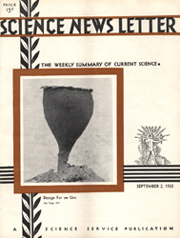From the September 2, 1933, issue

URN PATTERNS EXISTED LONG BEFORE URNS WERE MADE
Urns, whether for flowers or for funeral ashes, have always had much the same pattern; so much so, that the shape immediately and automatically evokes the name. But that shape existed on the earth long before the earliest neolithic potter smoothed out the walls of the first urn with skillful, muddy fingers. Numerous species of plants, and of animals of the lower orders as well, found that it met the problems of their existence admirably. Here, for example, is a kind of puffball that has been making perfect little urns for nobody knows how many millennia, as caught by the lens of Cornelia Clarke’s magnifying camera. And here as elsewhere, the shape evoked the name; for the botanist who christened the genus called it Urnia.
ULTRA-SHORT RADIO WAVES SENT AROUND CURVATURE OF EARTH
Guglielmo Marconi has again confounded the prophets. He has shown that his ultra-short radio waves are able to pass through mountains and even curve around the surfaces of the earth to receiving stations far below the horizon.
History repeats itself again. For in 1901 Prof. H.M. Poincaré, distinguished French mathematician, predicted that communication would be limited to about 165 miles. In that same year Marconi demonstrated that electrical waves could be sent and received across the Atlantic.
Modern theorists had predicted that the ultra-short waves would act like light waves from a searchlight and would not be detectable beyond the horizon. Messages have now been sent from the inventor’s yacht to an experimental station 94 miles away in inland Italy, more than three times the predicted distance.
The explanation for this property of the waves to bend about the earth and to curve around objects is not known. Theorists have attacked the problem by treating the radio waves as light waves and have extended the diffraction theory which explains the microscopic bending of light around corners to the ultra-short radio waves, but without marked success.
DEAD SEAS HOARD MINUTE AMOUNTS OF “HEAVY” WATER
The new “heavy” water, science’s latest strange addition to common chemical substances, has been found in detectable quantities in the salt deposits at the bottom of extinct stagnant seas.
Dr. E.B. Washburn, chief chemist of the Bureau of Standards, has announced that the richest natural source of this peculiar type of water is to be found in native borax, a salt that exists in the beds of dead seas. The water of crystallization of this native borax contains seven parts of heavy water in every million parts of ordinary water.
Samples taken from the largest existing bodies of stagnant water, the Dead Sea in Asia Minor and the Great Salt Lake in Utah, when purified showed an increased weight over pure ordinary water. The Dead Sea water was heavier by two parts in a million and the Great Salt Lake sample was three parts in a million in excess of standard light water.







